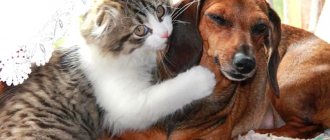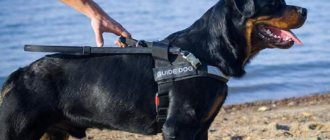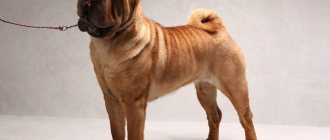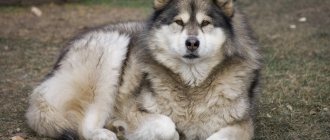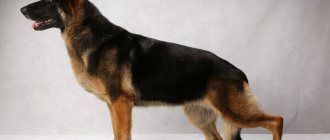Huskies are one of those dogs whose appearance cannot go unnoticed.
It is thanks to its beautiful exterior that many people want to get such a pet, but there is no need to rush.
Representatives of this breed have a rather complex character, so before buying a puppy you should read the description of the breed and reviews of the owners in order to have an idea of the breed as a whole and evaluate your strengths.
Description of the breed
The Husky has a harmoniously built muscular body, straight limbs, well-muscled hips and oval, compact paw pads.
To meet the breed standard, dogs must have:
- head proportional to the body of medium size;
- slightly rounded skull, tapering towards the eyes;
- a clearly defined transition from the forehead to the not very long muzzle;
- slanted almond-shaped eyes, which can be blue, blue, gray or brown, are often found in individuals with heterochromia;
- medium-sized V-shaped ears with slightly rounded tips;
- black, brown or gray, depending on coat color, nose;
- scissor bite;
- deep and wide chest;
- straight back.
Adult males grow to 53.5-60 cm at the withers with a weight of 20.5-28 kg, the height of females is 50.5-56 cm, and body weight is 15.5-23 kg.
Price
Prices depend on many factors, including the purpose of the purchase. The puppy receives a certain class, which is determined depending on appearance, behavioral characteristics and health status.
Category class:
- Pets are companion dogs that will become family pets.
- Breeding - such puppies will be able to participate in exhibition and sporting competitions.
- The shows are true champions.
You should not buy huskies from private sellers, especially if the puppy is given away for free. The dog will probably be of dubious origin.
On average, the cost of Siberian huskies varies from 15,000 to 100,000 rubles, depending on their purpose.
A dog in the most budget pet category will cost 15-25,000 rubles, show level puppies 60-100,000 rubles, and a breed can be purchased for 30-50,000 rubles.
Character traits
Huskies can be described as affectionate, good-natured dogs and not prone to aggression. They are very sociable, friendly and need constant attention.
Representatives of this breed are people-oriented and become attached to their owner . At the same time, they will not remain faithful to one person if that person does not constantly prove to them his leadership and shows disrespect for the pet.
These dogs are accustomed to existing with people on an equal footing, being their partners and companions, and will not tolerate disdainful treatment.
Huskies have a complex and obstinate character, which not everyone can cope with . They are characterized by stubbornness, willfulness, independence and the desire to dominate.
Many husky character traits are inherited.
Advantages and disadvantages
The main advantages of huskies that the owners of these dogs, especially those who have small children, talk about are their friendly disposition, lack of aggression and the ability to get along with kids..
In addition, representatives of this breed have an attractive appearance, good health and a high degree of endurance.
Also husky:
- know how to find a common language with other pets;
- do not have an unpleasant odor;
- sociable;
- independent;
- clean;
- smart and quick-witted;
- adapt well to new conditions.
Speaking about the disadvantages of the breed, it should be noted that these dogs:
- stubborn and willful;
- prone to dominance;
- shed heavily;
- cannot stand loneliness;
- prone to prolonged howling, digging holes and escapes;
- do not tolerate heat well;
- need constant communication.
Huskies do not have guarding or guarding instincts, so they should not be bred to guard the house.
Health
Huskies are dogs characterized by good health and good endurance. But, there are some diseases to which they may be susceptible. First of all, it is hip dysplasia. This is a fairly serious pathology that affects the health of the entire musculoskeletal system. Huskies, unable to move normally, have a hard time suffering from this disease. In some cases, only surgery can really help, although this is a last resort. Physiotherapeutic and drug treatment is most often prescribed.
Another group of problems that Huskies may encounter are ophthalmological diseases. Most often we are talking about progressive retinal atrophy and juvenile cataracts.
A cataract is a hardening of the pupil that interferes with normal vision. Juvenile cataracts usually develop in the breed before the age of 2 years. You can get rid of it surgically, although few pet owners agree to this. The main reasons: high risks of unsuccessful intervention and the high cost of the operation.
Retinal atrophy provokes dystrophic changes, which over time lead to complete blindness. Usually two eyes are affected. It is also noted that representatives of the Husky breed are prone to epilepsy.
Is it suitable for living in an apartment?
Huskies are large dogs, the height of males at the withers reaches a maximum of 60 cm, and females - 56 cm, so they can be kept in city apartments.
At the same time, we must not forget about the hyperactivity of these animals and their need for physical activity. Therefore, in the case of apartment living, they must be walked at least 2 times a day for 1.5-2 hours.
Is it suitable for outdoor use? Can it protect the house?
Representatives of this breed have a two-layer coat consisting of hard guard hairs and soft, dense undercoat, thanks to the thickness of which they can easily tolerate even severe frosts down to -50-60 °C.
Therefore, huskies can live outside without any problems throughout the year . They only need a spacious, equipped enclosure that does not limit their freedom.
It is also important that there is a canopy in the yard, under which in the summer the dog can hide not only from bad weather, but also from the sun, since heat, unlike frost, is difficult for huskies to endure.
CAREFULLY!
These dogs are not suitable for being kept on a chain.
Representatives of this breed do not have a guard instinct, so you should not have them as house guards.
Provided they are properly raised, they can be trained to guard the territory, but this will manifest itself in no more than warning the owners about the visit of strangers.
Features of walking without a leash
The breed is northern, bred for persistent hard work, transporting goods and people over long distances. Therefore, when going outside, the animal feels free. Huskies love to run a lot and for a long time, they are curious and rarely obedient, so they often get lost and run away. A weak and slow person will not be able to hold and later catch up with the dog. Many owners keep their pets off a leash to avoid such situations, although this breed needs free runs.
Very often, city authorities prohibit walking medium and large dogs without muzzles and leashes. In this case, the pet must be taken outside the populated area: to the river, to the landing, to the lake, avoiding public crowded places.
Dog handlers recommend teaching your Husky a leash from the first walks and not letting him go in urban environments until he is completely submissive, where the dog can get lost or get hit by a car. The animal needs to know all the commands and be able to carry them out under any conditions. Although this breed is difficult to train to obedience.
How active is the breed? What kind of people is it suitable for?
Huskies have never been a decorative breed; they were bred exclusively for hard work, which required endurance and energy..
Despite the fact that these dogs have not been used for work for a long time, nothing has changed: they are still energetic animals, characterized by hyperactivity and the need for physical activity.
Wherever huskies live - in an apartment or on the street - they need regular long walks, including active games, physical activity and elements of training.
These dogs will be ideal pets for people who prefer to lead an active lifestyle and have a strong character, willpower and unconditional leadership qualities necessary to raise a dog.
Relationship with the owner
A dog can have different relationships with its owner:
- The most common and correct model is the leadership of the owner and the obedience of the pet. If the Husky understands that a person is a leader, then he will obey him. This can be achieved through long-term training.
- Another acceptable model of relationships is fraternal. When the dog and the owner live and work on equal terms: they share food, bed, house, work together, performing their functions. Then the pet will consider the person an equal and obey him as a partner.
Two wrong parenting options: an idol dog and a rad dog. In the first case, the family exalts the pet over its own needs, which is why the Husky becomes uncontrollable. In the second, the animal is abused, which destroys its psyche.
How to feel about loneliness
They are sociable dogs that have lived in packs throughout their history, so they need constant interaction with people and other animals.
You cannot limit the communication of huskies and isolate them . Spending a long time alone has a negative impact on the health and mental state of these dogs.
Who to choose - a boy or a girl?
When choosing between a dog and a bitch, you should know that their character and temperament have some differences.
Girls are more affectionate, obedient and flexible, they are easier to train . They have a softer and calmer character, but at the same time they are cunning and capable of many tricks to get what they want.
In addition, during estrus, the character and behavior of the pet may change, and its performance decreases.
Boys are calmer, more resilient and strong . They are not characterized by cunning, they are honest and straightforward, and tend to openly demonstrate their desire to be the leader of the “pack.”
Despite the friendly disposition inherent in the breed, they can show aggression towards foreign males in order to defend their leadership and superiority.
Good or evil?
This is one of the few dog breeds whose representatives are absolutely not characterized by aggressive behavior.
Huskies are friendly towards everyone and will even prefer to make friends with strangers and strangers, which, in fact, makes them poor guards and watchmen..
A certain degree of aggression is possible only in relation to other people's cats, which these dogs perceive as objects of hunting, and neighboring dogs, to whom husky boys strive to demonstrate their superiority.
How does he treat children?
Huskies are natural nannies. The Chukchi, to whom these dogs owe their appearance, used them to warm children, knowing that they were not in danger.
Representatives of this breed get along well with children - they enjoy playing and babysitting with babies and become very attached to them..
Sometimes this attachment is so strong that dogs do not want to leave the child for a minute and always strive to be close to him, even during sleep.
It is better not to leave a very small child alone with a dog, since a rather large and energetic pet can inadvertently injure the baby.
Children's guilt
Children love to jump, run, and play pranks. Until a certain age, people don’t understand how not to treat a dog. They often behave unceremoniously. They may hug you roughly or pull your tail incorrectly. Grab an ear, step on a paw, jump on its back. Take food, toys, distract from sleep. This causes discomfort for the dog.
Statistics show that 90% of bites occur due to the carelessness of children who incorrectly interpret facial expressions and do not read warning signals. Parents should monitor their child’s behavior towards the husky and prevent conflict from arising.
How picky is she about feeding?
These dogs do not have any special requirements for the type of food and can eat both natural products and industrial food with equal pleasure .
Moreover, they are generally not picky about food and can eat absolutely anything, even what is forbidden to them.
Therefore, it is important to ensure that your pet does not have access to prohibited products, household chemicals, medications and other things hazardous to health, and also not to allow him to pick up anything on the street while walking.
No contact
Not gonna get us!
The most important reason. The owner can adore his dog, humanize it, treat it like a child. Through the “rose-colored glasses” of love, it is not visible that the pet does not reciprocate. For example, an owner, while walking a pet, constantly says something to it, tries to give commands, but the animal does not turn its head. Let's keep silent about the dog following commands.
If you let such a pet off the leash (or he breaks off it on his own), either scream or not - don’t call. Why should a dog return to someone with whom he is not interested, when suddenly new horizons and spaces have opened up? The dog will run off to explore the world, that’s all.

